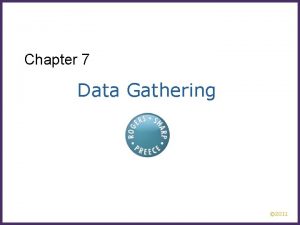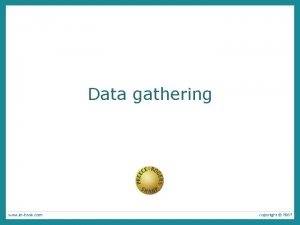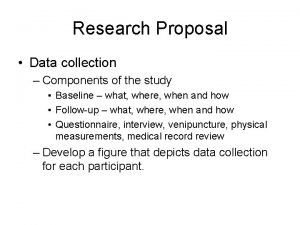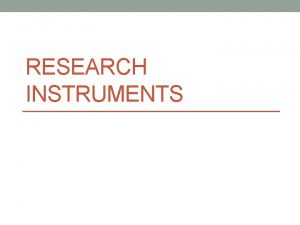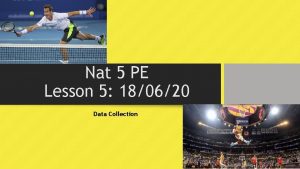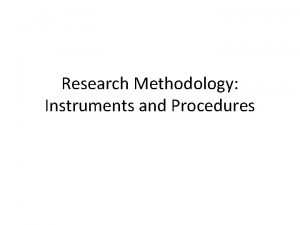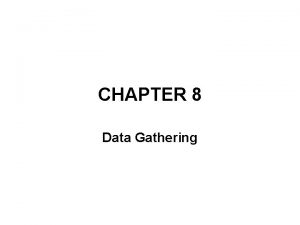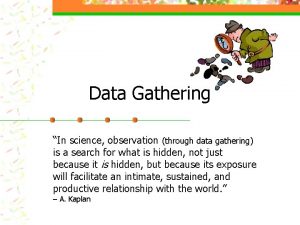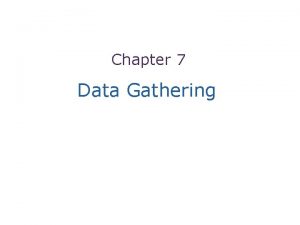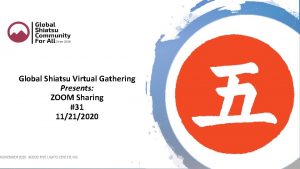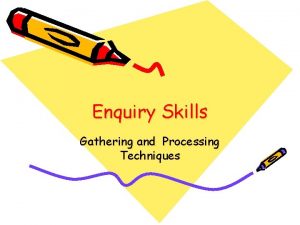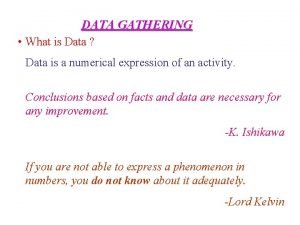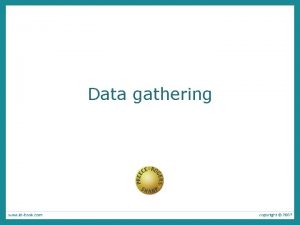Chapter 7 Data Gathering 2011 Overview Five key
























- Slides: 24

Chapter 7 Data Gathering © 2011

Overview · Five key issues of data gathering · Data recording · Interviews · Questionnaires · Observation · Choosing and combining techniques © 2011

Five key issues 1. Setting goals • Decide how to analyze data once collected 2. Identifying participants • Decide who to gather data from 3. Relationship with participants • • Clear and professional Informed consent when appropriate 4. Triangulation • Look at data from more than one perspective 5. Pilot studies • Small trial of main study © 2011

Data recording • Notes, audio, video, photographs • Notes plus photographs • Audio plus photographs • Video © 2011

Interviews • Unstructured - are not directed by a script. Rich but not replicable. • Structured - are tightly scripted, often like a questionnaire. Replicable but may lack richness. • Semi-structured - guided by a script but interesting issues can be explored in more depth. Can provide a good balance between richness and replicability. © 2011

Interview questions • Two types: − ‘closed questions’ have a predetermined answer format, e. g. , ‘yes’ or ‘no’ − ‘open questions’ do not have a predetermined format • Closed questions are easier to analyze · Avoid: − Long questions − Compound sentences - split them into two − Jargon and language that the interviewee may not understand − Leading questions that make assumptions e. g. , why do you like …? − Unconscious biases e. g. , gender stereotypes © 2011

Running the interview • Introduction – introduce yourself, explain the goals of the interview, reassure about the ethical issues, ask to record, present any informed consent form. • Warm-up – make first questions easy and nonthreatening. • Main body – present questions in a logical order • A cool-off period – include a few easy questions to defuse tension at the end • Closure – thank interviewee, signal the end, e. g, switch recorder off. © 2011

Enriching the interview process • Props - devices for prompting interviewee, e. g. , a prototype, scenario © 2011

Questionnaires • Questions can be closed or open • Closed questions are easier to analyze, and may be done by computer • Can be administered to large populations • Paper, email and the web used for dissemination • Sampling can be a problem when the size of a population is unknown as is common online © 2011

Questionnaire design • The impact of a question can be influenced by question order. • Do you need different versions of the questionnaire for different populations? • Provide clear instructions on how to complete the questionnaire. • Strike a balance between using white space and keeping the questionnaire compact. • Decide on whether phrases will all be positive, all negative or mixed. © 2011

Question and response format • ‘Yes’ and ‘No’ checkboxes • Checkboxes that offer many options • Rating scales – Likert scales – semantic scales – 3, 5, 7 or more points? • Open-ended responses © 2011

Encouraging a good response • • Make sure purpose of study is clear Promise anonymity Ensure questionnaire is well designed Offer a short version for those who do not have time to complete a long questionnaire If mailed, include a stamped addressed envelope Follow-up with emails, phone calls, letters Provide an incentive 40% response rate is high, 20% is often acceptable © 2011

Advantages of online questionnaires · · · Responses are usually received quickly No copying and postage costs Data can be collected in database for analysis Time required for data analysis is reduced Errors can be corrected easily © 2011

Problems with online questionnaires · Sampling is problematic if population size is unknown · Preventing individuals from responding more than once · Individuals have also been known to change questions in email questionnaires © 2011

Observation • Direct observation in the field – Structuring frameworks – Degree of participation (insider or outsider) – Ethnography • Direct observation in controlled environments • Indirect observation: tracking users’ activities – Diaries – Interaction logging © 2011

Structuring frameworks to guide observation • - The person. Who? - The place. Where? - The thing. What? • The Goetz and Le. Compte (1984) framework: - Who is present? - What is their role? - What is happening? - When does the activity occur? - Where is it happening? - Why is it happening? - How is the activity organized? © 2011

Ethnography (1) · Ethnography is a philosophy with a set of techniques that include participant observation and interviews · Debate about differences between participant observation and ethnography · Ethnographers immerse themselves in the culture that they study · A researcher’s degree of participation can vary along a scale from ‘outside’ to ‘inside’ · Analyzing video and data logs can be timeconsuming · Collections of comments, incidents, and artifacts are made © 2011

Ethnography (2) • Co-operation of people being observed is required • Informants are useful • Data analysis is continuous • Interpretivist technique • Questions get refined as understanding grows • Reports usually contain examples © 2011

Online Ethnography • Virtual, Online, Netnography • Online and offline activity • Interaction online differs from face-toface • Virtual worlds have a persistence that physical worlds do not have • Ethical considerations and presentation issues are different © 2011

An ethnographic project for you … • Join www. Active. Worlds. com or go to another chat room of your choice • Active. Worlds is a 3 -D chatroom environment in which you can visit different environments and chat with the people that you meet there • To use Active. Worlds you will need to check the instructions that they provide and download the appropriate software to run on your computer © 2011

• Select one of the worlds to visit and choose an avatar (a graphical personification) to represent you. • Spend one to two hours doing an ethnographic study. • Use one of the frameworks discussed in the previous slides to guide you and write a one or two page report about your study. • Also notice and report on any usability issues you encounter and on user experiences in this environment. © 2011

Direct observation in a controlled environment • Think-aloud technique Indirect observation • Diaries • Interaction logs • Web analytics © 2011

Choosing and combining techniques • Depends on – The focus of the study participants involved nature of the technique resources available © 2011

Summary • Three main data gathering methods: interviews, questionnaires, observation • Five key issues of data gathering: goals, choosing participants, triangulation, participant relationship, pilot • Interviews may be structured, semi-structured or unstructured • Questionnaires may be on paper, online or telephone • Observation may be direct or indirect, in the field or in controlled setting • Techniques can be combined depending on study focus, participants, nature of technique and available resources © 2011
 Five key issues of data gathering
Five key issues of data gathering 5 key issues in data gathering
5 key issues in data gathering Data quality and data cleaning an overview
Data quality and data cleaning an overview Data quality and data cleaning an overview
Data quality and data cleaning an overview Data quality and data cleaning an overview
Data quality and data cleaning an overview Data gathering for quantitative research
Data gathering for quantitative research Data gathering procedure in research example
Data gathering procedure in research example Apa itu data requirement gathering
Apa itu data requirement gathering Data warehouse requirements gathering
Data warehouse requirements gathering Data gathering procedure
Data gathering procedure Research proposal data collection
Research proposal data collection Example of research instrument questionnaire
Example of research instrument questionnaire Nat 5 pe
Nat 5 pe Gathering weather data
Gathering weather data It is part where you indicate the research instrument
It is part where you indicate the research instrument Example of data gathering procedure
Example of data gathering procedure Methods of gathering data higher pe
Methods of gathering data higher pe What is the setting of gathering blue
What is the setting of gathering blue T. trimpe 2006 http //sciencespot.net/ answer key
T. trimpe 2006 http //sciencespot.net/ answer key Key resources examples
Key resources examples Key partners
Key partners Section 8-2 photosynthesis an overview
Section 8-2 photosynthesis an overview Overview elements and their properties answer key
Overview elements and their properties answer key Five years have past five summers with the length
Five years have past five summers with the length One in five challenge
One in five challenge
